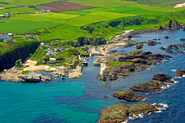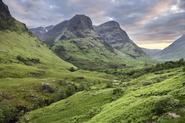Erin go Bragh ("Ireland Forever") | |||||||
| Anthem | "Amhrán na bhFiann" | ||||||
| Capital | Difelin | ||||||
| Largest city | Duibhlinn (Difelin) | ||||||
| Other cities | Glaschú, Béal Feirste, Corcaigh, Luimneach, Gaillimh, Inbhir Nis, Dúlais | ||||||
| Language | Irish | ||||||
| Religion | 85.1% Christianity
—78.3% Roman Catholic —2.6% Church of Ireland 14.2% No religion | ||||||
| Ethnic Groups main |
Irish 80% | ||||||
| others | Irish travellers 1%
other European 9.5% Asian 2.4% African 2.1% other 1.5% unspecified 2.6% | ||||||
| Demonym | Irish | ||||||
| Legislature | Federated semi-direct democracy | ||||||
| Uachtarán | Leo de Varad, Cumann na nGaedhael (CnaG)
Caitríona Ní Mháirtín, Comhaontas Glas (CG) | ||||||
| Population | 12,119,342 (2020) | ||||||
| Currency | Euro (€) | ||||||
Ireland (Irish: Éire [ˈeːɾʲə], also known as the Confederation of Ireland (Comhdháil na hÉireann), is a country in north-western Europe.
Etymology[]
History[]
Society[]
Geography[]
Ireland consists of the island of Hibernia (alternatively called Great Ireland and, historically, Little Britain) and the northern portion of the island of Britain.

Ireland is known for its greenery
The western landscape of Hibernia mostly consists of rugged cliffs, hills and mountains. The central lowlands are extensively covered with glacial deposits of clay and sand, as well as significant areas of bogland and several lakes. The highest point is Corrán Tuathail (1,038.6 m or 3,407 ft), located in the Na Cruacha Dubha mountain range in the southwest. The Sionainne River, which traverses the central lowlands, is the longest river in Hibernia at 386 kilometres or 240 miles in length. The west coast is more rugged than the east, with numerous islands, peninsulas, headlands and bays.
Though once densely forested, the island has been void of great expanses of forestland since the building of the Great Irish Armada starting in the 17th century.
Dagmar Ó Riain-Raedel, Irish historian, discovered that the popular continental European reputation of the island of Hibernia was very high during the medieval period, with many writers offering glowing reviews of the island on Europe’s western edge. It was even compared to the Garden of Eden, being another “land of milk and honey.”

Ireland still posses many forests
One of the earliest medieval writers about Ireland was the seventh-century scholar Isidore of Seville. In his encyclopaedic work Etymologiae he notes:
Ireland, also known as Hibernia, is an island next to Britannia, narrower in its expanse of land but more fertile in its site. It extends from southwest to north. Its near parts stretch towards Iberia (Hiberia) and the Cantabrian Ocean (i.e. the Bay of Biscay), whence it is called Hibernia; but it is called Scotia, because it has been colonised by tribes of the Scoti. There no snakes are found, birds are scarce, and there are no bees, so that if someone were to sprinkle dust or pebbles brought from there among beehives in some other place, the swarms would desert the honeycombs.

Albain contains Ireland's highest point and is broadly a sparsely populated and mountains region
Bede, for example, writers in his Ecclesiastical History of the English People, explains:
Ireland is broader than Britain, is healthier and has a much milder climate, so that snow rarely lasts for more than three days. Hay is never cut in summer for winter use nor are stables built for their beasts. No reptile is found there nor could a serpent survive; for although serpents have often been brought from Britain, as soon as the ship approaches land they are affected by the scent of the air and quickly perish. In fact almost everything that the island produces is efficacious against poison. For instance we have seen how, in the case of people suffering from snake-bite, the leaves of manuscripts from Ireland were scraped, and the scrapings put in water and given to the sufferer to drink. These scrapings at once absorbed the whole violence of the spreading poison and assuaged the swelling. The island abounds in milk and honey, nor does it lack vines, fish, and birds. It is also noted for the hunting of stags and roe-deer.

The island of Hibernia contains most of Ireland's population, in places such as the town Cionn tSáile
Riain-Raedel explains, that “in their descriptions of the heavenly paradise, the absence of snakes was cited enthusiastically by Christian writers. In Ireland’s case, the absence of reptiles was probably due to natural reasons but it nonetheless provided Christian writers, aware of the biblical analogy, with the possibility of creating an inverted parallel. As was well known, the blissful state of paradise had been terminated through the intervention of evil in the shape of the snake. In snake-less Ireland, on the other hand, where a sinful state had reigned before the advent of Christianity, the people had redeemed themselves, innocence had returned and they were now, in the words of Bede, a ‘gens innoxia’. Within Ireland, therefore, the history of human salvation had come full circle.”
The northern part of the nation of Ireland is made up of Alban (Albain in Irish) and the The Isles. Alban is sparsely populated. The highest point in Alban is Bhen Nevis (Bheinn Nibheis in Irish), which is also the tallest mountain in both Ireland and the island of Britain.














